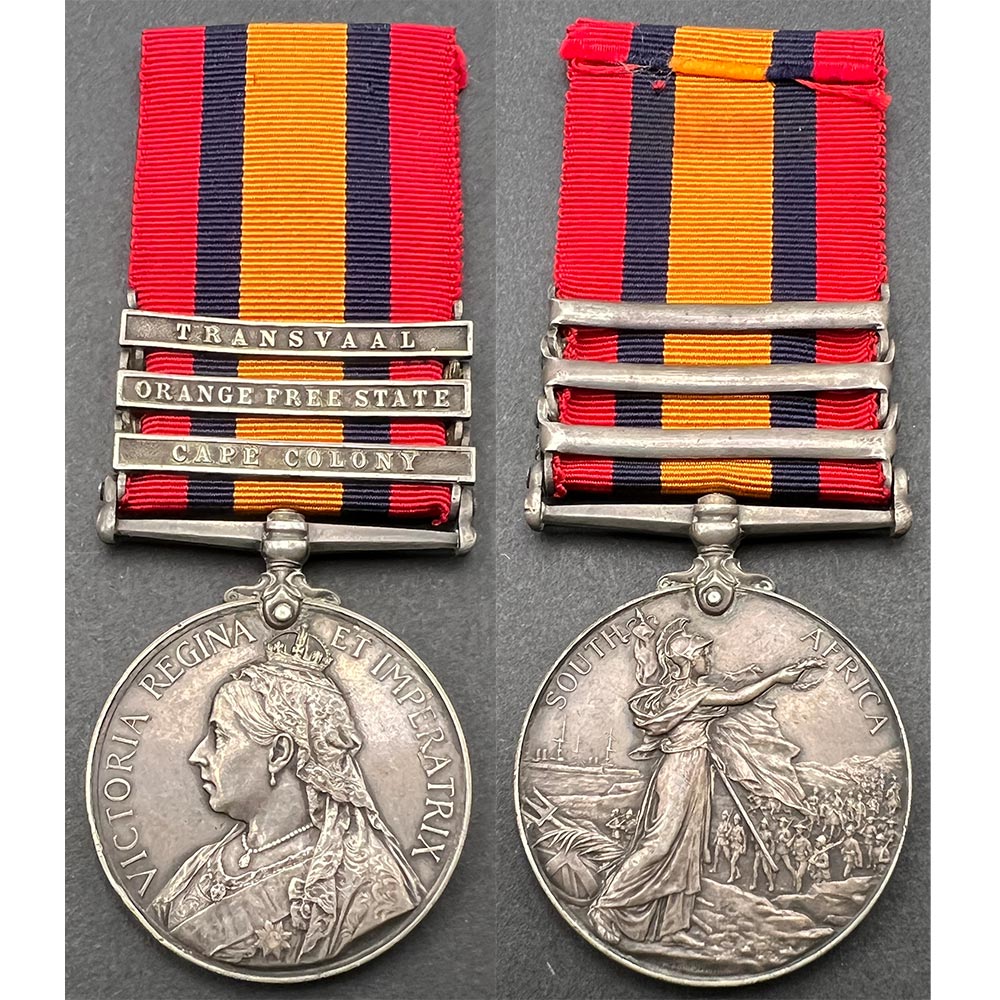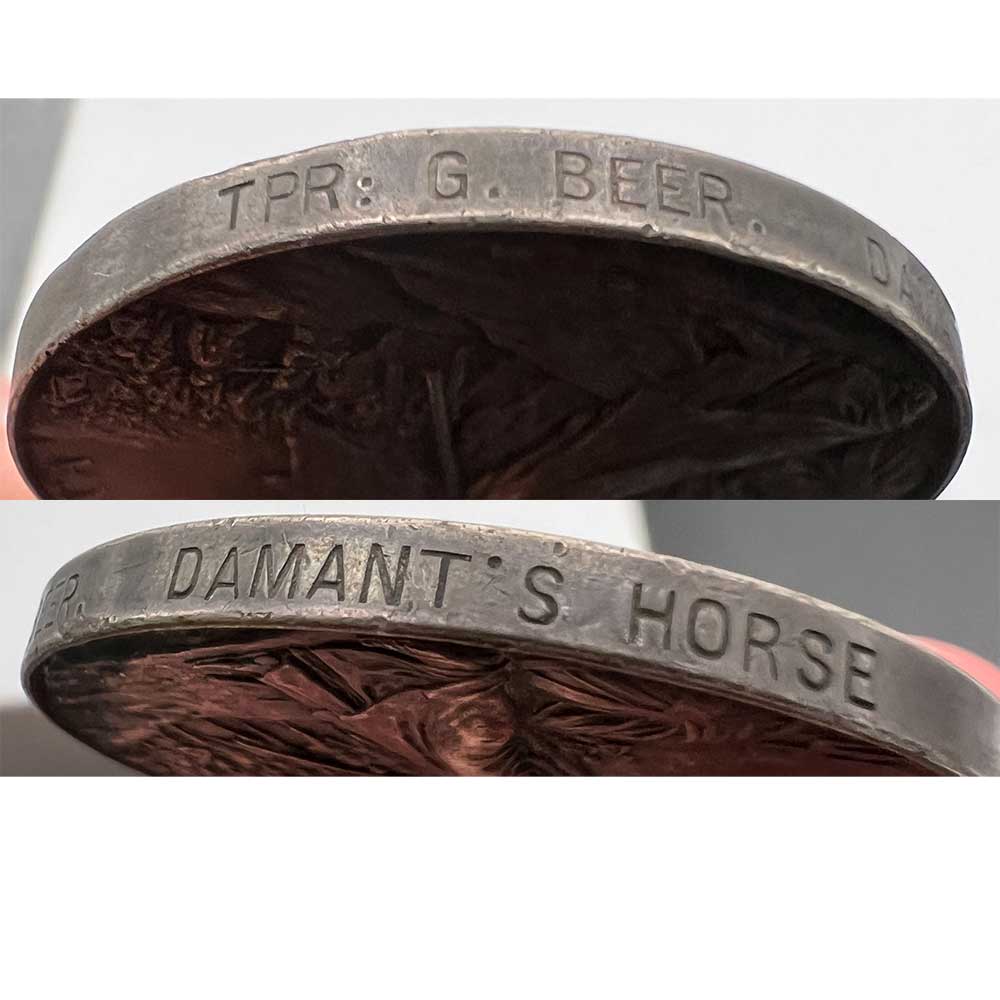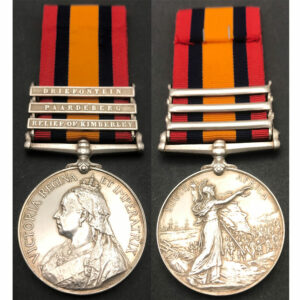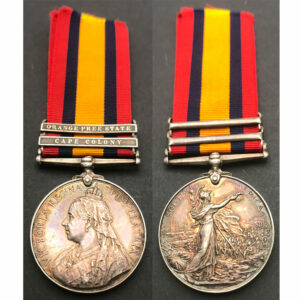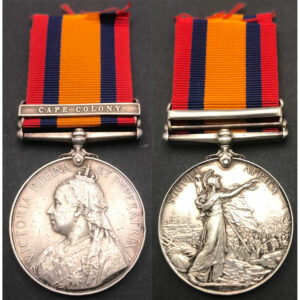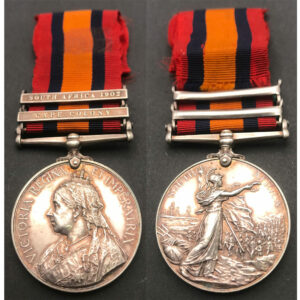Description
Queen’s South Africa Medal, 3 bars, Cape Colony, Orange Free State, Transvaal, Trooper George Beer, Damant’s Horse and Rimington’s Guides.
Officially impressed: “Tpr G. Beer. Damant’s Horse”
Confirmed on the medal roll.
George was born in Mile End Town, London during 1881.
The son of George (B 1855) and Mary A. Beer (B 1861), both of London.
George at the age of 21, signed up with Rimington’s Guides at Durban on 19th August 1901, listing his next of kin as his father George back in London, England.
He was 5 foot 9, 169 pounds and had worked as a Butcher.
He served with the regiment until his discharge on 17th February 1902.
During his time with the unit, the 2nd in Command, Damant took over the regiment and it became “Damant’s Horse.”
Following that he served with “Q Squadron Cape Colonial Forces” with number 579, earning the further dated 1901 and 1902 clasps (issued after the medal loose).
During his relatively time with Rimington’s Guides he would have seen quite some fighting.
The detailed page on Angloboerwar.com list the following notes during this period:
https://www.angloboerwar.com/unit-information/south-african-units/463-damants-horse
The despatch of 8th December 1901 contains the following passage, very flattering to the work of both the leaders mentioned: “Since the fifteenth of November (1901) successful operations have been carried out by Colonel Rimington and Major Damant, operating from Frankfort, along the valley of the Vaal. Frequent captures have been made by these officers, who have exhibited marked ability in adapting themselves to the peculiar methods of Boer warfare. It would be tedious, indeed, to give in detail the many minor successes which have rewarded their energy and ingenuity. The most important capture effected by Colonel Rimington was that of Commandant Buys, who fell into his hands after being wounded in a skirmish with a detachment of the Railway Pioneer Regiment, to whose assistance Colonel Rimington had gone”.
And the Christmas day action at Tweefontein:
In the despatch of 8th January 1902, after referring to De Wet’s successful rushing of the camp of a Yeomanry battalion at Tweefontein, in the Harrismith district, in the early morning of 25th December 1901, Lord Kitchener said: “Another very determined attack was also made upon Lieutenant Colonel Damant’s column in the vicinity of Tafel Kop, between Frankfort and Vrede. On the evening of the 19th December, this column, together with Colonel Rimington’s troops, who had also moved from Heilbron to Frankfort, marched from the latter town towards Tafel Kop to cover the extension of the blockhouse line in that direction. They moved throughout the night by two parallel roads, some three miles apart, and to the north of the proposed line of blockhouses, and, after circling round Tafel Kop, were at daybreak in the vicinity of Bacchante Farm. Here a resolute attack was suddenly made by some 800 Boers, under General Wessels, upon Colonel Damant’s advanced guard, who were deceived by the khaki disguise of the enemy, and their clever imitation of the formation usual with regular mounted troops. To complete the deception the enemy even fired volleys, as they approached Colonel Damant’s men, in the general direction of some Boers who were escaping across the front of the two forces. This clever ruse enabled them to get sufficiently close to Colonel Damant’s troops to anticipate them by a few yards in the occupation of the crest of a kopje which commanded the whole field, including the guns and the main body of our troops. Lieutenant Colonel Damant’s men displayed the utmost gallantry, holding on to their inferior position so as to save the two guns which accompanied the advanced guard, and every officer and man, except four, of the leading troops was shot down before reinforcements, which were pushed forward from the main body and from Colonel Rimington’s column directly firing commenced, could arrive upon the scene. The appearance of these reinforcements compelled the Boers to relinquish their attack, and they fled over the Wilge River, pursued for some miles by Colonel Rimington’s troops. Since the date of this affair the troops of Colonels Rimington and Damant have continued to operate in the neighbourhood of Tafel Kop, where I am reinforcing them by two of the newly formed battalions of Royal Artillery Mounted Rifles, and by the Canadian Scouts under Major Ross”. In his telegram of the 21st December Lord Kitchener said that the losses of the column were 2 officers and 20 men killed, and 3 officers and 17 men wounded. These turned out to be rather greater; the 39th Battery—one section—had 6 killed and 8 wounded. The losses of Damant’s Horse were severe, but nothing like those of the 91st Company Imperial Yeomanry, which had 32 hit out of 40, and, in the words of Lord Kitchener, “sacrificed itself almost to a man to save Damant’s guns”. Lieutenant Colonel Damant was wounded in four places, Lieutenant Shand (Cameron Highlanders, attached Damant’s Horse) was killed, Lieutenant C H A Wilson was wounded, 5 men were killed and 10 wounded.”
